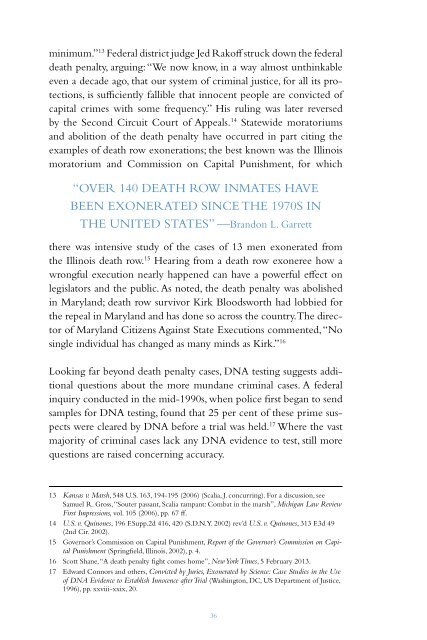PENALTY
DBk0302s7Xm
DBk0302s7Xm
Create successful ePaper yourself
Turn your PDF publications into a flip-book with our unique Google optimized e-Paper software.
minimum.” 13 Federal district judge Jed Rakoff struck down the federal<br />
death penalty, arguing: “We now know, in a way almost unthinkable<br />
even a decade ago, that our system of criminal justice, for all its protections,<br />
is sufficiently fallible that innocent people are convicted of<br />
capital crimes with some frequency.” His ruling was later reversed<br />
by the Second Circuit Court of Appeals. 14 Statewide moratoriums<br />
and abolition of the death penalty have occurred in part citing the<br />
examples of death row exonerations; the best known was the Illinois<br />
moratorium and Commission on Capital Punishment, for which<br />
“OVER 140 DEATH ROW INMATES HAVE<br />
BEEN EXONERATED SINCE THE 1970S IN<br />
THE UNITED STATES” —Brandon L. Garrett<br />
there was intensive study of the cases of 13 men exonerated from<br />
the Illinois death row. 15 Hearing from a death row exoneree how a<br />
wrongful execution nearly happened can have a powerful effect on<br />
legislators and the public. As noted, the death penalty was abolished<br />
in Maryland; death row survivor Kirk Bloodsworth had lobbied for<br />
the repeal in Maryland and has done so across the country. The director<br />
of Maryland Citizens Against State Executions commented, “No<br />
single individual has changed as many minds as Kirk.” 16<br />
Looking far beyond death penalty cases, DNA testing suggests additional<br />
questions about the more mundane criminal cases. A federal<br />
inquiry conducted in the mid-1990s, when police first began to send<br />
samples for DNA testing, found that 25 per cent of these prime suspects<br />
were cleared by DNA before a trial was held. 17 Where the vast<br />
majority of criminal cases lack any DNA evidence to test, still more<br />
questions are raised concerning accuracy.<br />
13 Kansas v. Marsh, 548 U.S. 163, 194-195 (2006) (Scalia, J. concurring). For a discussion, see<br />
Samuel R. Gross, “Souter passant, Scalia rampant: Combat in the marsh”, Michigan Law Review<br />
First Impressions, vol. 105 (2006), pp. 67 ff.<br />
14 U.S. v. Quinones, 196 F.Supp.2d 416, 420 (S.D.N.Y. 2002) rev’d U.S. v. Quinones, 313 F.3d 49<br />
(2nd Cir. 2002).<br />
15 Governor’s Commission on Capital Punishment, Report of the Governor’s Commission on Capital<br />
Punishment (Springfield, Illinois, 2002), p. 4.<br />
16 Scott Shane, “A death penalty fight comes home”, New York Times, 5 February 2013.<br />
17 Edward Connors and others, Convicted by Juries, Exonerated by Science: Case Studies in the Use<br />
of DNA Evidence to Establish Innocence after Trial (Washington, DC, US Department of Justice,<br />
1996), pp. xxviii-xxix, 20.<br />
More states and local police departments are now recording interrogations<br />
and have adopted best practices for eyewitness lineups. A few<br />
have also improved quality control and standards for forensics. Those<br />
reforms are inexpensive, and they benefit law enforcement; they help<br />
to identify the guilty and clear the innocent. However, they are all<br />
being implemented at the local and state levels.<br />
120<br />
100<br />
80<br />
60<br />
40<br />
20<br />
0<br />
No challenge Verdict reversed Challenge unsuccessful<br />
Eyewitness testimony<br />
56% challenged<br />
Additional reforms could improve the quality of post-conviction<br />
review. One state, North Carolina, has created an Innocence<br />
Inquiry Commission, to focus on judicial review of claims of innocence.<br />
Unlike post-conviction and habeas courts, which are sharply<br />
restricted by complex procedural barriers to relief, this Commission<br />
just investigates whether a person is innocent and should be exonerated<br />
by a three-judge panel. Other courts have made improvements<br />
on the front end by insisting that juries be carefully informed of the<br />
limitations of evidence, such as eyewitness testimony. Much more can<br />
be done, however, both to improve judicial gatekeeping to prevent<br />
wrongful convictions in the first place and to review convictions after<br />
the fact.<br />
CONCLUSION<br />
Forensic testimony<br />
31% challenged<br />
Informant testimony<br />
34% challenged<br />
Confessions<br />
59% challenged<br />
In the United States, because some jurisdictions happened to save<br />
crime scene evidence that could be tested years later, there has been<br />
36 37


